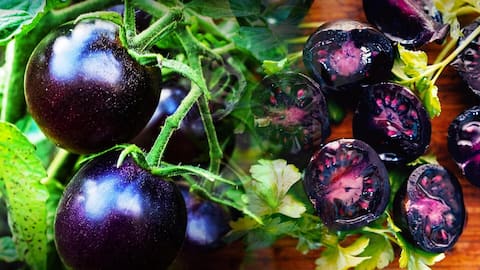US gardeners are growing purple tomatoes! Know their making, benefits
What's the story
For the first time ever, home gardeners in the United States can now grow genetically modified (GMO) "purple tomatoes," thanks to Norfolk Plant Sciences. These unique tomatoes are the result of two decades of research and development, and their creators hope they will help change public opinion on GMO foods. The tomatoes went on sale last Saturday. Until now, GMO foods were only available to commercial producers in the US.
Creation
The making of the purple tomato
The purple tomato was developed by adding color genes from snapdragon flowers to the tomato plant. This was done using bacteria to insert DNA into the host organism, a process that can happen naturally. The outcome is a tomato packed with anthocyanin, a health-boosting compound found in blueberries, blackberries, eggplant, and purple cabbage. According to Nathan Pumplin, CEO of Norfolk Healthy Produce, the purple tomato contains as much anthocyanin per weight as blueberries or eggplants.
Color
The purple color behind the tomatoes
Per Norfolk Plant Sciences, the purple tomato offers consumers a vibrant and nutritious complement to their diets. Created by Professor Cathie Martin at the prestigious John Innes Centre in Norwich, UK, the purple tomato is derived from two genes found in the edible snapdragon flower, which gives it extraordinary antioxidant qualities. These genes produce the color purple, giving purple-skinned tomatoes, blueberries, blackberries, and eggplants their unique purple pigmentation.
Benefits
Health benefits and biofortification trends
Purple tomatoes are part of the biofortified food trend, which aims to increase the nutrient content of crops for health benefits. The goal here was to develop a tomato with high levels of anthocyanins. Anthocyanins, known for their anti-inflammatory properties, act as antioxidants to help neutralize unstable molecules in the body linked to aging and disease. Kathleen Hefferon, a microbiologist at Cornell University, thinks this trend will continue as people become more interested in their quality and longevity of life .
Comparison
Traditional breeding vs. genetic modification
While the purple tomato was created through genetic modification, traditional breeding methods have also produced anthocyanin-rich tomatoes like the "Indigo Rose." Jim Myers, a professor specializing in vegetable breeding at Oregon State University, notes that over 50 cultivars of Indigo Rose tomatoes have been developed through conventional breeding. However, GMO supporters argue that genetic engineering could revolutionize agriculture sustainably, benefiting both the environment and human health.
Future predictions
Overcoming negative perceptions of GMOs
Despite the potential benefits, purple tomatoes face challenges due to ongoing negative perceptions of GMOs. Reportedly, the U.S. Food and Drug Administration (FDA) has found no health risks associated with consuming GM foods currently on the market. Experts believe that if purple tomatoes gain acceptance and succeed, it could lead to the creation of more bioengineered crops, making nutritionaland health benefits more accessible to all.
